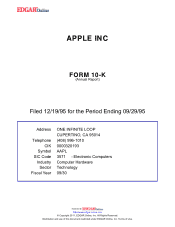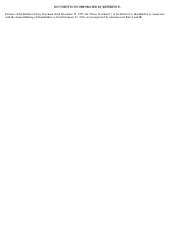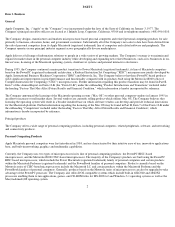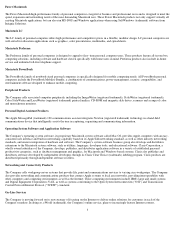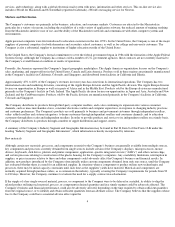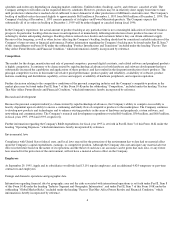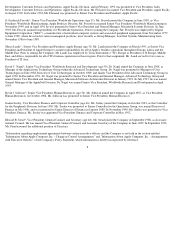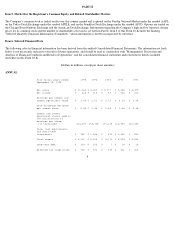Apple 1995 Annual Report Download - page 8
Download and view the complete annual report
Please find page 8 of the 1995 Apple annual report below. You can navigate through the pages in the report by either clicking on the pages listed below, or by using the keyword search tool below to find specific information within the annual report.schedules and order rates depending on changing market conditions. Unfilled orders (backlog) can be, and often are, canceled at will. The
Company attempts to fill orders on the requested delivery schedules. However, products may be in relatively short supply from time to time
until production volumes have reached a level sufficient to meet demand or if other production or fulfillment constraints exist. The Company's
backlog of unfilled orders decreased slightly to approximately $618 million at December 1, 1995 from $663 million at December 2, 1994. The
Company's backlog at December 1, 1995 consists primarily of its higher- end Power Macintosh products. The Company expects that
substantially all of its orders in backlog at December 1, 1995 will be either shipped or canceled during fiscal 1996.
In the Company's experience, the actual amount of product backlog at any particular time is not a meaningful indication of its future business
prospects. In particular, backlog often increases in anticipation of or immediately following introduction of new products because of over-
ordering by dealers anticipating shortages. Backlog often is reduced once dealers and customers believe they can obtain sufficient supply.
Because of the foregoing, as well as other factors affecting the Company's backlog, backlog should not be considered a reliable indicator of the
Company's future revenue or financial performance. Further information regarding the Company's backlog may be found under Part II, Item 7
of this Annual Report on Form 10-K under the subheading "Product Introductions and Transitions" included under the heading "Factors That
May Affect Future Results and Financial Condition," which information is hereby incorporated by reference.
Competition
The market for the design, manufacture and sale of personal computers, personal digital assistants, and related software and peripheral products
is highly competitive. It continues to be characterized by rapid technological advances in both hardware and software development that have
substantially increased the capabilities and applications of these products, and has resulted in the frequent introduction of new products. The
principal competitive factors in this market are relative price/performance, product quality and reliability, availability of software, product
features, marketing and distribution capability, service and support, availability of hardware peripherals, and corporate reputation.
Further discussion relating to the competitive conditions of the personal computing industry and the Company's competitive position in the
market place may be found under Part II, Item 7 of this Form 10-K under the subheading "Competition," included under the heading "Factors
That May Affect Future Results and Financial Condition," which information is hereby incorporated by reference.
Research and development
Because the personal computer industry is characterized by rapid technological advances, the Company's ability to compete successfully is
heavily dependent upon its ability to ensure a continuing and timely flow of competitive products to the marketplace. The Company continues
to develop new products and technologies and to enhance existing products in the areas of hardware and peripherals, system software, and
networking and communications. The Company's research and development expenditures totaled $614 million, $564 million, and $665 million,
in fiscal years 1995, 1994 and 1993, respectively.
Further information regarding the Company's R&D expenditures for fiscal year 1995 is set forth in Part II, Item 7 of this Form 10-K under the
heading "Operating Expenses," which information is hereby incorporated by reference.
Environmental laws
Compliance with United States federal, state, and local laws enacted for the protection of the environment has to date had no material effect
upon the Company's capital expenditures, earnings, or competitive position. Although the Company does not anticipate any material adverse
effects in the future based on the nature of its operations and the thrust of such laws, no assurance can be given that such laws, or any future
laws enacted for the protection of the environment, will not have a material adverse effect on the Company.
Employees
At September 29, 1995, Apple and its subsidiaries worldwide had 13,191 regular employees, and an additional 4,424 temporary or part-time
contractors and employees.
Foreign and domestic operations and geographic data
Information regarding financial data by geographic area and the risks associated with international operations is set forth under Part II, Item 8
of this Form 10-K under the heading "Industry Segment and Geographic Information", and under Part II, Item 7 of this Form 10-K under the
subheading "Global Market Risks," included under the heading "Factors That May Affect Future Results and Financial Condition," which
information is hereby incorporated by reference.
6

